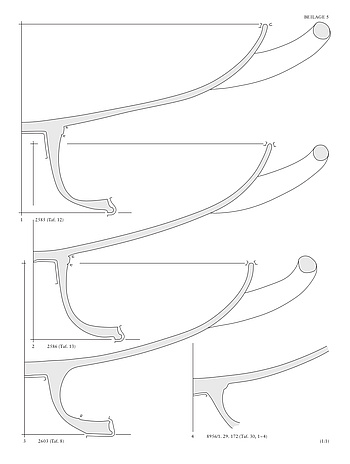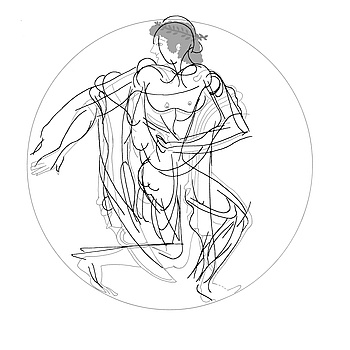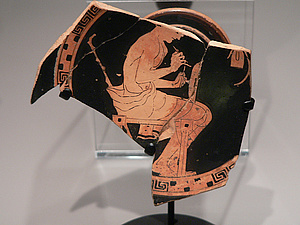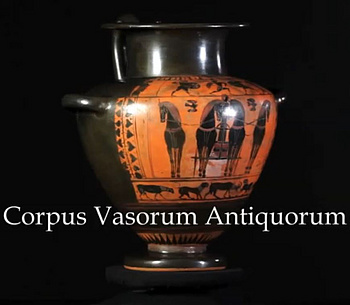The Material Basis
The Corpus Vasorum Antiquorum develops, documents and publishes ancient painted Greek ceramics as well as painted ceramics influenced by the Greeks in public museums and collections. The project material represents by no means the entire production of Greek fine ceramics. It is defined by the partially shifting collecting interests and aesthetic evaluations since the 18th century.
Regarded as works of art or at least as exemplary handicrafts, the vessels very rarely offer an archaeological context. On one hand this indeed diminishes the material’s historical source value. There are research issues regarding the consumers and recipients of the pictorial representations that can be better answered from find contexts. On the other hand, only the collection inventories of mostly well preserved vessels allow for a fundamental historical determination of the manufacturing and the depictions’ intention.
The large quantity of preserved vessels allows for a classifying attribution to potters, painters, workshops or manufacturing centres and for the resulting dating. Thus, the vases gain historical context.
The multitude of comparable vases facilitates the identification and interpretation of depicted contents as well as their correlation with the vessel’s functions. This allows for insights into the living environment and imaginative world of Greek antiquity.
Discovering
The project’s tasks are divided into three objectives. In the beginning there is the investigation of the material. This includes a detailed inspection of what is ancient and modern with each vessel.
Since many have been restored already during the 18th and 19th century, often a cleaning becomes necessary in close cooperation with the museum’s restorers, as the case arises an examination under UV light and sometimes even a complete disassembly, in order to differentiate the ancient parts from modern additions.
Also, the intensive search in the museum’s storerooms often results in finds of fragments unknown so far, or in bringing together vessel fragments that had been distributed over various museums.

Documenting
The documentation of vessels and fragments represents the central task, with photography as the most important medium. The better and the more precise the photos, the better they can help researchers to find answers to the questions they are asking the Greek vases. At best, even questions nobody is thinking of at the moment, questions that just may arise from new research interests in the future.
Photographic documentation of the head vessel Berlin F 2190 (CVA 103).
Move image with left mouse-key pressed down

In addition to the photography, which in particular reflects surface, colours, images and ornaments of the vase, the shape of the vessel is recorded by profile drawings.
The vessels’ proportions and especially the shaping of feet and rims can hint on a specific potter and the templates he used for his work. Much like the characteristics and the lines of the painting allow conclusions on individual painters.
Profile drawings of Attic drinking bowls on a CVA supplement (figure CVA 98)

Other drawings are needed when details are supposed to be shown that can't be documented with photography. These could be traces of lost paint applications or of inscriptions. Otherwise almost invisibly engraved preliminary sketches of the paintings provide insights in the painter’s approach and allow for identifying his personal style.
Preliminary drawings on a bowl Munich SH 2597 (figure: CVA 98)
Commenting
In contrast to the visual documentation, which is supposed to be a preferably timeless and lasting research tool, the catalogue text depends much more on the current state of research. On one hand the description points out things that can’t be made visible in photos and drawings. On the other hand, it provides help with the identification of the depicted objects and subjects. In a comment, the vessel and the painting are dated and classified through comparison. It also points out when and how the vase played a role in Classical Studies research so far, or if the vase may contribute to answering research questions.
Research and Digitization
The corpus project represents pure research. Its focus is therefore on providing scientific data and material. Current research questions beyond cataloguing are being discussed during international conferences taking place on a regular base since 2002. The results are published as supplementary series of the CVA Germany and should inform about the development and trends in research on ancient ceramics.
Since 2004, all corpus volumes of the international project can be freely accessed online via the database of Oxford University (CVA digital).
Literature
N. Hoesch – R. von den Hoff, Das Corpus Vasorum Antiquorum – ein modernes Forschungsinstrument, Akademie Aktuell 2006, H. 3, 16–19 (see Akademie Aktuell)
S. Schmidt, CVA Today. Some Remarks, in: Cahiers du Corpus Vasorum Antiquorum France (Paris 2014) 9–12 (see PDF)
W. van de Put, Corpus Vasorum Antiquorum: a Future for Ideals of the Past?, Forum Archaeologiae 74/III/2015 (see article)
N. Eschbach, Scherben bringen Glück. Von Jagdinstinkt und detektivischem Gespür: Anmerkungen zur Arbeit in Museen und Sammlungen für das Corpus Vasorum Antiquorum, Akademie Aktuell 2015, H. 2, 67–71 (see Akademie Aktuell)



